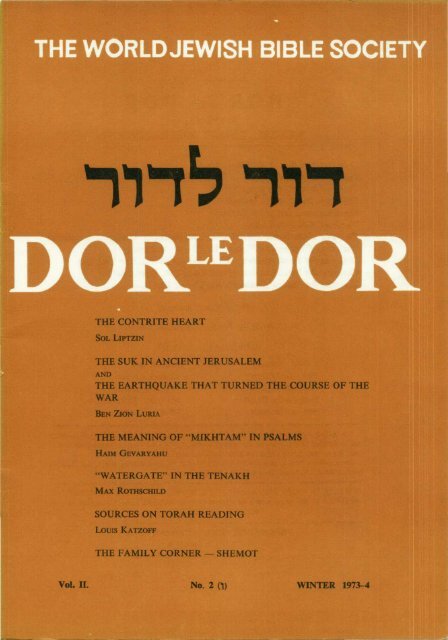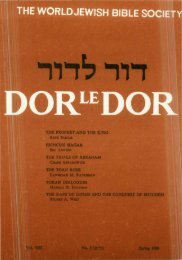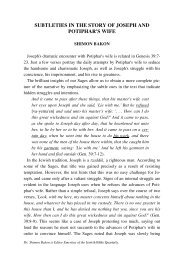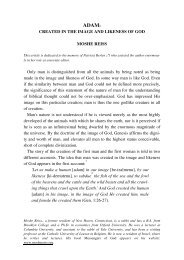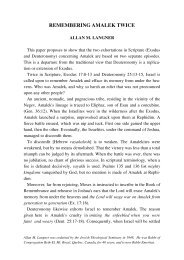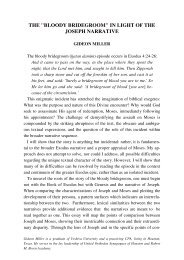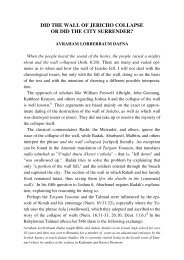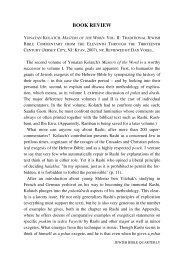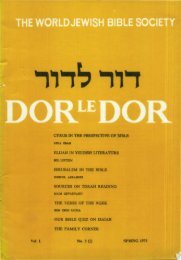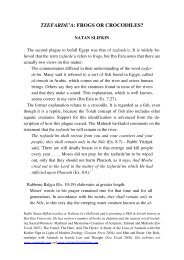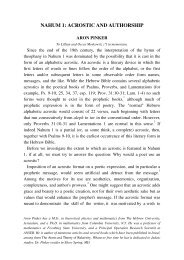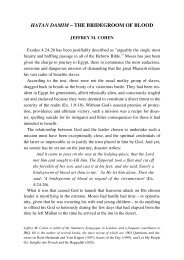The Suk in Ancient Jerusalem - Jewish Bible Quarterly
The Suk in Ancient Jerusalem - Jewish Bible Quarterly
The Suk in Ancient Jerusalem - Jewish Bible Quarterly
Create successful ePaper yourself
Turn your PDF publications into a flip-book with our unique Google optimized e-Paper software.
<strong>The</strong> later name, Tyropean Valley,<br />
of the Greek and Roman periods, is<br />
derived from what we might call,<br />
"the market place of the Tyrians",<br />
which <strong>in</strong> First Temple days was<br />
called the Makhtesh, because of its<br />
depression.<br />
It was the wealthy merchant<br />
group, both <strong>Jewish</strong> and Phoenician,<br />
who were addressed by the prophet<br />
4<br />
WORLD JEWISH BIBLE SOCIETY<br />
MEMBERSHIP (Tax deductible <strong>in</strong> USA)<br />
Membership Includes:<br />
Triennial Tanakh Study Calendar<br />
One-year subscription to Dor le-Dor<br />
Zephaniah: "And <strong>in</strong> that day, saith<br />
the Lord, hark, a cry from the fish<br />
gate and a wail<strong>in</strong>g from the second<br />
quarter and a great crash<strong>in</strong>g from<br />
the hills. Wail, ye <strong>in</strong>habitants of<br />
Makhtesh, for all the merchant<br />
people are undone and all they that<br />
were laden with silver are cut off"<br />
(Zephaniah 1 :10-11).<br />
. $ 10<br />
For Beth Mikra, Hebrew <strong>Quarterly</strong> AddS 5<br />
WORLD JEWISH Bma SoCJEl v<br />
9 Brenner Street<br />
<strong>Jerusalem</strong>, Israel<br />
Name<br />
Street<br />
Remittance for membership is enl'losf.!J<br />
City State Zip<br />
Special Subscription for Synagogues and Organizations<br />
Group memberships of S!X or more:<br />
To a s<strong>in</strong>gle address . . . . . . S 5<br />
Direct to homes of members S 6
f<strong>in</strong>d the path to moral liv<strong>in</strong>g an easy one. In Psalm LI he is shown as err<strong>in</strong>g,<br />
suffer<strong>in</strong>g, repent<strong>in</strong>g, and f<strong>in</strong>ally restored to grace. <strong>The</strong> David of this Psalm<br />
is no longer the bright, young shepherd who loomed upon the political and<br />
military horizon <strong>in</strong> the last years of Saul's reign. Nor is he the warrior hero<br />
about whom the defeated remnants of Israel rallied after the Battle of Gilboa.<br />
Far beh<strong>in</strong>d him are those glorious days when he, the chiefta<strong>in</strong> of a band of<br />
outlaws and guerilla-fighters, led his people to victory and splendor, ga<strong>in</strong><strong>in</strong>g<br />
for them the citadel of <strong>Jerusalem</strong> as their capital for all time. He has become<br />
the unchallenged k<strong>in</strong>g whose power is absolute and he has succumbed to· the<br />
corruption of power. Who dares oppose his will? When temptation comes to<br />
him as he catches sight of the wife of Uriah the Hittite, why should he resist it?<br />
Why should he not take Bath-sheba <strong>in</strong>to his harem? Adultery, murder- what<br />
is not permitted to a monarch unbound by restra<strong>in</strong>ts?<br />
When the Prophet Nathan presents a parallel situation <strong>in</strong> the case of a<br />
commoner, David correctly feels that such crimes committed by anyone else<br />
deserve the extreme penalty of death. He is shocked when told that the situation<br />
applies to him too. <strong>The</strong>re is one moral code, God's code as enunciated at<br />
S<strong>in</strong>ai. It <strong>in</strong>cludes the commandments: Thou shalt not murder! Thou shalt not<br />
commit adultery! It applies to the ruler upon the throne no less than to the<br />
humblest subject over whom he holds sway. Though a monarch, <strong>in</strong> his position<br />
of absolute power, may be able to elude human punishment and though he<br />
need fear no retribution emanat<strong>in</strong>g from man or woman, there is punishment<br />
for crimes committed aga<strong>in</strong>st the moral order of the universe, there is retribution<br />
emanat<strong>in</strong>g from the unrighteous act itself.<br />
David, hurled out of his complacent feel<strong>in</strong>g of omnipotence and reel<strong>in</strong>g<br />
under the rebukes of Nathan, still believes he can put on a show of repentance<br />
by means of sackcloth and ashes and can thus placate the supreme architect<br />
of the moral code so as to save his newborn son. But when this son dies, he<br />
realizes that no outward show of penitence can bribe God, s<strong>in</strong>ce God penetrates<br />
<strong>in</strong>to the <strong>in</strong>nermost reaches of the heart. It is then that the true enormity<br />
of his <strong>in</strong>iquity comes home to David.<br />
Psalm LI shows David <strong>in</strong> his most human aspect, not as a lord over others<br />
and not even as a lord over himself but as a broken person, crushed by the<br />
consciousness of his great guilt and <strong>in</strong> need of God's help and mercy <strong>in</strong> order<br />
to recover from his dejection at be<strong>in</strong>g a moral outcast.<br />
David's first outcry from the depth of his spiritual affliction is: "Have mercy<br />
upon me, 0 God, accord<strong>in</strong>g to thy lov<strong>in</strong>gk<strong>in</strong>dness." His appeal is not to the<br />
God of Justice, the God who did not let the monarch's s<strong>in</strong> go unpunished,<br />
though He did not exact the severest penalty, David's own death. This God<br />
of Justice did not grant David's plea for the survival of his new offspr<strong>in</strong>g.<br />
6
SPECIAL CHARACTERISTICS OF THESE SIX PSALMS<br />
<strong>The</strong>re is an <strong>in</strong>terest<strong>in</strong>g commonality <strong>in</strong> these six psalms. Note how they all<br />
beg<strong>in</strong> with a plea to God for help <strong>in</strong> time of trial, <strong>in</strong> some <strong>in</strong>stances <strong>in</strong>dicat<strong>in</strong>g<br />
the exact perilous circumstances, and a vow or declaration of gratitude somewhere<br />
along <strong>in</strong> the psalm, mostly near or at its conclusion.<br />
Psalm !6:<br />
Verse I - Keep me, 0 God for I have taken refuge <strong>in</strong> <strong>The</strong>e.<br />
Verse 2 - I have said unto the Lord: "thou art my Lord; I have no good<br />
but <strong>in</strong> <strong>The</strong>e."<br />
Psalm 56:<br />
Verses I and 2- A psalm of David, mikhtam; when the Philist<strong>in</strong>es took<br />
him <strong>in</strong> Gath. Be gracious unto me, 0 God, for man would swallow me up; all<br />
the day the enemy oppresses me.<br />
Verse !3- Thy vows are upon me 0 God: I will render thank-offer<strong>in</strong>gs<br />
unto <strong>The</strong>e.<br />
Psalm 57:<br />
Verses I and 2 - A psalm of David, Mikhtam; when he fled from Saul, <strong>in</strong><br />
the cave. Be gracious unto me, 0 God, be gracious unto me, for <strong>in</strong> <strong>The</strong>e hath<br />
my soul taken refuge; yea, <strong>in</strong> the shadow of Thy w<strong>in</strong>gs will I take refuge until<br />
calamities be overpast.<br />
Verse !0 - I will give thanks unto <strong>The</strong>e, 0 Lord, among the peoples;<br />
I will s<strong>in</strong>g praises unto <strong>The</strong>e among the nations.<br />
Psalm 58:<br />
Verse 2 - Do ye <strong>in</strong>deed speak as a righteous company? Do ye judge with<br />
equity the sons of men?<br />
Verse 12-And men shall say: "Verily, there is a God that judges <strong>in</strong> the earth.<br />
Psalm 59:<br />
Verses I and 2- A psalm of David, Mikhtam; when Saul sent, and they<br />
watched the house to kill. Deliver me from my enemies 0 my God; defend<br />
me from those who rise up aga<strong>in</strong>st me.<br />
Verses 17 and 18 - But as for me, I will s<strong>in</strong>g of Thy strength; yea, I will s<strong>in</strong>g<br />
aloud of Thy mercy <strong>in</strong> the morn<strong>in</strong>g ... 0 my strength, unto <strong>The</strong>e will I s<strong>in</strong>g<br />
praises, for God is my high tower, the God of my mercy.<br />
Psalm 60:<br />
Verses 2 and 3 - When he strove with Aram-naharayim and with Aramzova<br />
.... 0 God, Thou hast cast us off, Thou hast broken us down; Thou hast<br />
been angry; 0 restore us.<br />
Verse 8- God spoke <strong>in</strong> His hol<strong>in</strong>ess, that I would exult ...<br />
10
that might demolish the army; and<br />
this, despite the head<strong>in</strong>g of the<br />
psalm (verse 2) which refers to<br />
victory. It is most surpris<strong>in</strong>g that<br />
the psalm is <strong>in</strong>troduced by a notation<br />
of triumph of David's commander,<br />
Joab, over the Edomites and conta<strong>in</strong>s<br />
only a cry of anxiety. "That<br />
thy beloved may be delivered, save<br />
with Thy right hand and answer me"<br />
(60:7). "Give us help aga<strong>in</strong>st the<br />
adversary, for va<strong>in</strong> is the help of<br />
man" (60:13). What historical situation<br />
could have been the occasion<br />
of this psalm?<br />
REFERENCES TO A BA TrLE WITH<br />
EDOM<br />
We have several references to a<br />
battle of David's forces with Edom:<br />
And David got him a name<br />
when he returned from smit<strong>in</strong>g<br />
Edom (Septuag<strong>in</strong>t, Syriac translation<br />
and a number of ancient<br />
manuscripts) <strong>in</strong> the Valley of<br />
Salt.<br />
II Samuel 8:13<br />
Moreover Abishai the son of<br />
Zeruia smote the Edomites <strong>in</strong> the<br />
Valley of Salt.<br />
I Chronicles 18:12<br />
It seems that there is a connection<br />
between Psalm 60 and a martial<br />
confrontation with Edom. <strong>The</strong> place<br />
is the Valley of Salt. But where is<br />
the Valley of Salt? And what<br />
happened there that led to a po<strong>in</strong>t<br />
of despair depicted <strong>in</strong> the psalm?<br />
14<br />
SELA AND THE VALLEY OF SALT<br />
He (Amaziah) slew of Edom <strong>in</strong><br />
the Valley of Salt ten thousand<br />
and took Sela by war.<br />
II K<strong>in</strong>gs 14:7<br />
From a later engagement with<br />
Edom we f<strong>in</strong>d the Judean k<strong>in</strong>g,<br />
Amaziah, contend<strong>in</strong>g with the Edomites<br />
<strong>in</strong> the Valley of Salt, result<strong>in</strong>g<br />
<strong>in</strong> the conquest of the Edomite<br />
capital, Sela (Petra).<br />
From the proximity of Sela to the<br />
Valley of Salt <strong>in</strong> the II K<strong>in</strong>gs<br />
account, we might reconstruct the<br />
geographical sett<strong>in</strong>g of Abishai's<br />
clash with the Edomites.<br />
To reach Sela by way of the<br />
Valley of Salt, one starts from the<br />
Arava, south of the Dead Sea,<br />
which is more than I ,000 feet below<br />
sea level, and climbs to a height of<br />
over 4,000 feet above sea level.<br />
Though there are a number of<br />
wadis (valleys) <strong>in</strong> the area, there is<br />
only one approach upward, through<br />
a canyon towered by steep heights.<br />
Once <strong>in</strong> the canyon, there is no way<br />
out for the length of about seven<br />
miles. <strong>The</strong>re is no turn<strong>in</strong>g left or<br />
right, for the sheer cliffs overhang<strong>in</strong>g.<br />
WHY WAS EDOM COVETED?<br />
That the mounta<strong>in</strong>s of Edom<br />
were sought after by Israel is<br />
evident from a number of Biblical<br />
references. Its lure stemmed mostly<br />
from its copper deposits which were<br />
so coveted, such as Timna, Punon<br />
and the City of Copper.
JERUSALEM IN THE BIBLE<br />
BY SHMUEL ABRAMSKI<br />
Our first two articles <strong>in</strong> this series dealt with the earliest Biblical references to<br />
<strong>Jerusalem</strong>, up through the Davidic period. This chapter cont<strong>in</strong>ues with Solomon's<br />
period.<br />
SOLOMON'S JERUSALEM<br />
Solomon cont<strong>in</strong>ued <strong>in</strong> his father David's ways, erect<strong>in</strong>g many build<strong>in</strong>gs <strong>in</strong><br />
the royal capital. <strong>Jerusalem</strong> extended over the Temple Mount and over the<br />
City of David to the south on the eastern hill. <strong>The</strong> two sections were connected<br />
by build<strong>in</strong>gs, the first of which was erected <strong>in</strong> David's time. It is known as "the<br />
fortress." <strong>The</strong> k<strong>in</strong>g was concerned with the fortification of the capital, and<br />
repaired the parts that were vulnerable dur<strong>in</strong>g David's reign. He closed the<br />
breach <strong>in</strong> the City of David (I K<strong>in</strong>g, I :27). <strong>The</strong> reference is to the fortifications<br />
<strong>in</strong> the northern part of the city, for David had breached the wall on the side<br />
of the fortress of Zion. Solomon completed the fortifications <strong>in</strong> this part of the<br />
city.<br />
"SILVER LIKE STONES"<br />
In those days, <strong>Jerusalem</strong> was the commercial center of many k<strong>in</strong>gdoms,<br />
from Palmyra <strong>in</strong> the nort;, to Arabia <strong>in</strong> the south. <strong>The</strong> city grew <strong>in</strong> splendour.<br />
I' seems that there were stables for the quarter<strong>in</strong>g of horses and chariots too<br />
(I K<strong>in</strong>gs I 0 :26). <strong>The</strong> people of that generation who remembered the modest<br />
beg<strong>in</strong>mngs of the city and on whose hearts was still engraved the wander<strong>in</strong>g<br />
from the Judean desert to the fortress of Zion, exaggerated the greatness and<br />
opulence of the new royal city. An ancient tradition, preserved <strong>in</strong> the Book of<br />
K<strong>in</strong>gs, speaks <strong>in</strong> grandiose terms of the opulence of Zion <strong>in</strong> Solomon's day:<br />
"And the K<strong>in</strong>g made silver to be <strong>in</strong> <strong>Jerusalem</strong> as stones, and cedars made he<br />
to be as the sycamore trees that are <strong>in</strong> the Lowland for abundance" (ibid.<br />
10:27). <strong>The</strong> treasures of the East were imported from Arabia and Africa,<br />
<strong>in</strong>to <strong>Jerusalem</strong>: gold, silver, ivory, the choicest woods, and precious stones<br />
(ibid. 10:11, 12).<br />
THE QUEEN OF SHEBA IN JERUSALEM<br />
When the Queen of Sheba visited <strong>Jerusalem</strong> from South Arabia, she greatly<br />
admired the glories of Solomon's K<strong>in</strong>gdom: "And when the queen of Sheba<br />
had seen.. . the house that he had built, and the food of his table, and<br />
the sitt<strong>in</strong>g of his servants, and the attendance of his m<strong>in</strong>isters, and their<br />
20
apparel, and his cupbearer.;, and his bu rot offer<strong>in</strong>g whtch he offered <strong>in</strong> the<br />
house of the Lord, there was no more spira 10 he,.-· (I Km2s 10:4-5). She presented<br />
the K<strong>in</strong>g oflsrae' with the very best of the Land o! ;,)heba <strong>in</strong> South Arabia,<br />
"and she gave the Kmg a hu11dred and tweucy talents of gold, and of spices<br />
very great store, and ptteJous stones; there came no more such abundance of<br />
spices as these which che Queen o! Sheba gave to K<strong>in</strong>g Solomon" (ibid. 10:10).<br />
This should not 1 Je regarded as a typical legend of the East, for latest research<br />
proves that Sou h Arabia was already, <strong>in</strong> the first half of the first millenium<br />
B.C. E., the source and ma<strong>in</strong> transfer po<strong>in</strong>t of aromatic spices for the civilized<br />
world of those times, to lands like Egypt, Mesopotamia, Palest<strong>in</strong>e, Syria, and<br />
perhaps to Asia M<strong>in</strong>or. From this biblical account we learn that spices,<br />
which were so much sought after by the courts of the ancient East, reached<br />
Solomon's court <strong>in</strong> <strong>Jerusalem</strong> too.<br />
THE PALACE OF THE KING AND THE TEMPLE OF GOD<br />
<strong>The</strong> uniqueness of <strong>Jerusalem</strong> was not, however, its material splendor, for<br />
the city began to rank as a centre of religious practice already dur<strong>in</strong>g David's<br />
reign. In Solomon's day, it became the focus of Israel's faith, but only after<br />
many generations had elapsed was it transformed <strong>in</strong>to the nation's only centre<br />
of ritual. <strong>The</strong> two structures which Solomon had built on the Temple Mount<br />
-the Temple of God and the royal palace- gave the city a unique character<br />
throughout the generations: a vibrant centre of the monotheistic faith.<br />
<strong>The</strong> foundations of the Temple were laid <strong>in</strong> the fourth year of Solomon's<br />
reign (I K<strong>in</strong>gs 6: I), and the period of its construction lasted seven years.<br />
<strong>The</strong> Temple stood until <strong>Jerusalem</strong> was destroyed <strong>in</strong> 586 o.c.E. Dur<strong>in</strong>g the<br />
course of that period of about four centuries it underwent certa<strong>in</strong> changes and<br />
improvements at the hands of the House of David, but fundamentally it<br />
rema<strong>in</strong>ed unchanged until the exile. From the very beg<strong>in</strong>n<strong>in</strong>g, the Temple was<br />
designed not only for sacrifices and ceremonial worship, but also as a place of<br />
prayer, as a religious meet<strong>in</strong>g place, and as a symbolic dwell<strong>in</strong>g place for the<br />
God of Israel. When the Temple was completed, Solomon declared: "I have<br />
surely built <strong>The</strong>e a house of habitation, a place for <strong>The</strong>e to dwell <strong>in</strong> for ever"<br />
(ibid. 8: 13).<br />
Solomon's temple endowed the royal city with special splendour. Near it<br />
stood the royal palace with its own special build<strong>in</strong>gs: !he porch of pillars; the<br />
porch of the throne (or of judgement), the house of Pharaoh's daughter, and<br />
additional structures (ibid. 7:1, 6-8). Actually, all these constituted one<br />
network of buitd<strong>in</strong>gs (ibid. 7:1, 6, 121. <strong>The</strong>re was no partition between the<br />
royal palace and the Temple of God (II K<strong>in</strong>gs !I :16, 19, 20).<br />
We know of no other such close proximity - to the extent of complete<br />
21
<strong>in</strong>tegration - between a royal palace and a temple, with the exception of<br />
Assyria. <strong>The</strong> residences of the Pharaohs <strong>in</strong> the ·Egyptian temples were temporary<br />
apartments. <strong>The</strong> palace of Sargon II, the Assyrian K<strong>in</strong>g, resembled<br />
Solomon's build<strong>in</strong>gs <strong>in</strong> its general architectural plan, but its Temple was for<br />
the private use of the k<strong>in</strong>g and was not meant for the use of the public.<br />
KING AND PRIEST<br />
<strong>The</strong>re is no precise parallel, <strong>in</strong> eastern lands, to the dist<strong>in</strong>ct character of<br />
Solomon's structures, and they do not even have a basis <strong>in</strong> the ancient traditions<br />
of the Canaanite ritual of Lachish, Megiddo, Shechem, Jericho and<br />
Beth She'an. <strong>The</strong> m<strong>in</strong>iature sanctuary unearthed <strong>in</strong> the royal palace of Samaria<br />
was meant, most likely, for private use only. We can learn from Solomon's<br />
arrangement that the basis of his rule was founded on religious authority<br />
and that at least at the beg<strong>in</strong>n<strong>in</strong>g of the monarchy, the Israelite k<strong>in</strong>g held the<br />
authority of the priesthood (I Sam. 13:8-15; II Sam. 6:7-18; 8:18, 24-5;<br />
I K<strong>in</strong>gs 3:4, 15; 8:62-65). It was this proximity of the house of government<br />
to the house of God which transformed the build<strong>in</strong>gs constructed by Solomon<br />
<strong>in</strong>to the "k<strong>in</strong>g's sanctuary" and "the royal house" (Amos 7:13).<br />
Solomon's Temple po<strong>in</strong>ted up the dist<strong>in</strong>guished position held by <strong>Jerusalem</strong><br />
with<strong>in</strong> the realm and the Israelite k<strong>in</strong>gdom's unique character. <strong>The</strong>re was a<br />
connection between the monarchy and the preced<strong>in</strong>g tribal regime; the new<br />
regime .neither negated nor reversed the old, but was an <strong>in</strong>novation with<strong>in</strong><br />
its cont<strong>in</strong>uity. <strong>The</strong> Temple <strong>in</strong> <strong>Jerusalem</strong> was based on the tradition of the<br />
portable tabernacle from the times of the wander<strong>in</strong>g <strong>in</strong> the wilderness. <strong>The</strong><br />
House of God imparted some of its hol<strong>in</strong>ess on the royal palace, endow<strong>in</strong>g<br />
David's k<strong>in</strong>gdom with greater stability, on account of its devotion to ritual<br />
(cf. Ezek. 43 :5).<br />
SPLENDOR AND HOLINESS<br />
<strong>The</strong> conditions peculiar to the Israelite K<strong>in</strong>gdom dur<strong>in</strong>g its earliest days<br />
necessitated a concentration of power and authority <strong>in</strong> the hands of the k<strong>in</strong>g,<br />
the outward expression of which was the complete <strong>in</strong>terconnection between<br />
Temple and royal palace. This concentration was sufficient to halt opposition<br />
to the government which existed <strong>in</strong> Israel even prior to the sett<strong>in</strong>g up of the<br />
monarchy; the orig<strong>in</strong> of this opposition was <strong>in</strong> the old tribal regime whose<br />
outstand<strong>in</strong>g symbol was the ohe/ (tent or tabernacle} <strong>in</strong> contrast to the bayit<br />
(house or temple).<br />
In <strong>Jerusalem</strong>, the capital of the House of David, from the very outset, new<br />
methods of construction were comb<strong>in</strong>ed with aspects of the traditional past.<br />
Royalty was orda<strong>in</strong>ed by the God of Israel and was expressed <strong>in</strong> the aff<strong>in</strong>ity<br />
22
etween the palace and the Temple. <strong>The</strong> capital had two faces already <strong>in</strong><br />
David's time: the city of splendour, enjoy<strong>in</strong>g the delights of the Orient, and<br />
the Holy City, based on the traditional, simple life of the wilderness. <strong>The</strong>se are<br />
the first expressions of the future city of the ideal k<strong>in</strong>g, "A shoot out of the<br />
stock of Jesse."<br />
THE KINGDOM AND THE SERVICE oF Goo<br />
It seems that the manner of construction of the Temple po<strong>in</strong>ts up the <strong>in</strong>dependence<br />
and orig<strong>in</strong>ality of thought <strong>in</strong>herent <strong>in</strong> the Israelite monarchy. No<br />
K<strong>in</strong>g of Israel, no matter how s<strong>in</strong>ful and wicked he was, ever claimed to be<br />
God or His div<strong>in</strong>e representative on earth. <strong>The</strong> k<strong>in</strong>g's power rested on the<br />
pillars of tradition, from the beg<strong>in</strong>n<strong>in</strong>g of nationhood, and was limited by<br />
laws and customs of time immemorial. <strong>The</strong> fact that the royal palace was<br />
next to the Temple and under its protection bears witness to the status of the<br />
K<strong>in</strong>g of Israel. <strong>The</strong> rulers of Judea drew their royal authority from Mount<br />
Zion, which itself was well-founded <strong>in</strong> div<strong>in</strong>e selection. <strong>The</strong> essence and purpose<br />
of the Temple was to be a symbolic dwell<strong>in</strong>g place for the God of Israel and<br />
a clear sign of the devotion of the people to the House of David. <strong>The</strong> foreign,<br />
technical styles of the Phoenicians and Canaanites could not <strong>in</strong>fluence the<br />
unique nature of the Israelite House of God.<br />
<strong>The</strong> Temple did not become the sole centre of worship all at once. <strong>The</strong><br />
<strong>Bible</strong> often stresses how deeply <strong>in</strong>gra<strong>in</strong>ed was the ritual of "the high places"<br />
(bamoth) among the people, who cont<strong>in</strong>ued to offer sacrifices upon them to the<br />
God of Israel even after the days of David and Solomon. After the division of<br />
the K<strong>in</strong>gdom (930 B.C.E.), the K<strong>in</strong>gdom of Israel was severed from the Temple<br />
<strong>in</strong> <strong>Jerusalem</strong>, which became the central place of worship for the Judean K<strong>in</strong>gdom<br />
only. But even <strong>in</strong> Judea, despite the opposition of powerful k<strong>in</strong>gs like<br />
Asa, Jehoshaphat and Hezekiah, the people cont<strong>in</strong>ued to sacrifice and burn<br />
<strong>in</strong>cense on the bamoth. It was only <strong>in</strong> the period of K<strong>in</strong>g Josiah that the bamoth<br />
were f<strong>in</strong>ally condemned. <strong>The</strong> rema<strong>in</strong>s of local worship were eradicated by<br />
force and the Temple became the sole place for div<strong>in</strong>e worship. <strong>The</strong> commandments<br />
<strong>in</strong> Deuteronomy regard<strong>in</strong>g the uniqueness of the Temple became the<br />
law of the land <strong>in</strong> the Judean K<strong>in</strong>gdom.<br />
Already <strong>in</strong> the days of the first Temple, the House of God was renowned for<br />
its universalism <strong>in</strong> the spirit of the unique character of <strong>Jewish</strong> monotheism.<br />
In the vision of Isaiah, son of Amoz, on the greatness of the mounta<strong>in</strong> of the<br />
Lord <strong>in</strong> the end of days, are hidden h<strong>in</strong>ts of opposition to idolatry. Neither<br />
Egypt nor Mesopotamia, the civilized nations of antiquity, were dest<strong>in</strong>ed to<br />
become the spiritual centre of nations and k<strong>in</strong>gdoms. <strong>The</strong> Tower of Babel<br />
orig<strong>in</strong>ated <strong>in</strong> man's pride and his thrust heavenwards; and this was the root<br />
23<br />
il r<br />
, '
as their commentaries and monographs show aga<strong>in</strong> and aga<strong>in</strong>. <strong>The</strong>y are much<br />
more spar<strong>in</strong>g with emendations than their Protestant colleagues, who often<br />
make a virtue of necessity and aga<strong>in</strong> and aga<strong>in</strong> seek refuge <strong>in</strong> conjectures and<br />
emendations <strong>in</strong>stead of prob<strong>in</strong>g the language and style of the transmitted<br />
text.<br />
As may be concluded from my earlier remarks, the second common characteristic<br />
of this generation is its polemical attitude to "Old Testament" research.<br />
Its philological and historical standards were of course valid also for <strong>Jewish</strong><br />
<strong>Bible</strong> research. However, its prejudice <strong>in</strong> treat<strong>in</strong>g the Hebrew <strong>Bible</strong> merely as<br />
the "Old Testament", that is to say, as a prelim<strong>in</strong>ary to the New Testament,<br />
seemed to <strong>Jewish</strong> scholars to block the way to a true understand<strong>in</strong>g of the <strong>Bible</strong>,<br />
which should be measured by its own criteria as Torah, i.e. as an autonomous<br />
doctr<strong>in</strong>e of life claim<strong>in</strong>g absolute validity, and not by foreign standards<br />
imposed from outside.<br />
If the historian is <strong>in</strong>deed entitled to JUdge biblical literature not only from<br />
its contemporary historical sett<strong>in</strong>g but also with regard to its <strong>in</strong>fluence on<br />
posterity, <strong>Jewish</strong> <strong>Bible</strong> research does just that with a view to later Judaism, and<br />
values the <strong>Bible</strong> as the first historical phase of <strong>Jewish</strong> culture and Hebrew<br />
language. <strong>The</strong>refore it may not be without importance that most of the <strong>Jewish</strong><br />
scholars to whom we have referred took up <strong>Bible</strong> studies as mature men who<br />
had already achieved their own understand<strong>in</strong>g of Judaism. Cassuto was<br />
orig<strong>in</strong>ally a historian and the author of a famous monograph on the history<br />
of the Jews of Florence. Kaufmann started his career with his brilliant sociological<br />
analysis Golah ve-Nekhar ("Diaspora and Foreign Lands" - Hebrew<br />
Vol. I, II, 1929, 1930). Buber had already ga<strong>in</strong>ed a reputation as a philosopher<br />
and student of Hassidism when he turned to the <strong>Bible</strong>. It is thus hardly surpris<strong>in</strong>g<br />
that the historical view of these scholars was <strong>in</strong>evitably directed to<br />
post-biblical <strong>Jewish</strong> culture culm<strong>in</strong>at<strong>in</strong>g <strong>in</strong> the modern <strong>Jewish</strong> renaissance<br />
movement. In their op<strong>in</strong>ion, the New Testament should be understood <strong>in</strong> the<br />
context of the conflict<strong>in</strong>g spiritual trends of the Second Temp1e era, and<br />
therefore as an <strong>in</strong>tegral part of <strong>Jewish</strong> studies, as is exempli-fied <strong>in</strong> the two<br />
monographs of Joseph Klausner on Jesus and Paul.<br />
THE PRESENT STATE OF BIBLE RESEARCH IN ISRAEL<br />
In conclusion, a few short remarks on the present state of <strong>Bible</strong> research <strong>in</strong><br />
Israel. I would not venture to deal with all the present developments <strong>in</strong> Israel<br />
<strong>in</strong> the different fields of <strong>Bible</strong> study, much less wo•lld I dare to pronounce<br />
judgment. I only want to dwell briefly on some common characteristics.<br />
Firstly, it should be stressed that there is no "Israeli school" <strong>in</strong> the sense of the<br />
Scand<strong>in</strong>avian school, the German historical-philological, the school of Form<br />
26
Criticism or that of "History of Tradition"; nor is there the slightest prospect<br />
of such a school emerg<strong>in</strong>g <strong>in</strong> the forseeable future. Ideological and methodological<br />
pluralism is still far too diverse to be reduced to a common denom<strong>in</strong>ator.<br />
But one may say that the present generation, <strong>in</strong> contrast to those which have<br />
been described above, has generally abandoned the polemical or sometimes<br />
apologetical positions <strong>in</strong> which men like Cassuto or Kaufmann entrenched<br />
them•elves. <strong>The</strong> <strong>in</strong>terest <strong>in</strong> militant polemics has waned, largely because there<br />
is no longer any daily contact with the Christian world. Closely related is the<br />
comparatively m<strong>in</strong>or <strong>in</strong>terest taken <strong>in</strong> theological and philosophical questions,<br />
connected with the <strong>Bible</strong>, at least on the part of professional <strong>Bible</strong> scholars.<br />
Curiously enough, this <strong>in</strong>terest is much more pronounced among philosophers,<br />
educationalists and others who take the liv<strong>in</strong>g mean<strong>in</strong>g of the <strong>Bible</strong> to heart.<br />
• When <strong>Bible</strong> scholars rejected theology, they threw out the baby with the<br />
bath water because they believed, mistakenly, that theology was identical with<br />
dogmatic th<strong>in</strong>k<strong>in</strong>g. On the other hand, the <strong>in</strong>timate contact of this generation<br />
with the Land of Israel - an <strong>in</strong>terest which is <strong>in</strong>tensified <strong>in</strong> breadth and depth<br />
by the present historical and political conditions - has already produced<br />
a lively concern with the historical, archaeological, geographical and other<br />
tangible aspects of <strong>Bible</strong> research. One of the advantages which this generation<br />
has is specialisation <strong>in</strong> all these fields, <strong>in</strong>clud<strong>in</strong>g oriental studies. One of the<br />
Christian scholars who deeply <strong>in</strong>fluenced the younger generation was the great<br />
archaeologist and orientalist, W.F. Albright, <strong>in</strong>itiator of the Archaeology of<br />
the Land of Israel. Also deserv<strong>in</strong>g of note is the <strong>in</strong>fluence of the Alt school,<br />
though this has been far less pronounced.<br />
NEW TRENDS IN BIBLE RESEARCH<br />
In the very near future, the Tel Aviv University Press is due to publish a<br />
comprehensive scholarly memorial volume <strong>in</strong> memory of a friend who died at<br />
an early age, Jacob Liver. This work, <strong>Bible</strong> and <strong>Jewish</strong> History, expresses, I<br />
venture to say, the present trends prevail<strong>in</strong>g <strong>in</strong> Israel. In order to give the reader<br />
some idea of the nature of this <strong>in</strong>tellectual atmosphere, I would like to mention<br />
an important feature of the Encyclopedia Miqrait (the Biblical Encyclopedia),<br />
<strong>in</strong>itiated by scholars of the last generation, but ma<strong>in</strong>ly written and edited by the<br />
present generation. So far, six substantial volumes have appeared; another<br />
two arc still to come. A comparison shows that the article Architecture (second<br />
volume) covers 89 columns, while the article Prophecy (fifth volume) accounts<br />
for only 41 columns: clear evidence that the ma<strong>in</strong> <strong>in</strong>terest of this compendium,<br />
which may presumably be regarded as the acme of the collective effort of<br />
Israel's young scholars, is not <strong>in</strong> theology but <strong>in</strong> the tangible problems of<br />
<strong>Bible</strong> history.<br />
27
Yet this dry, matter-of-fact presentation is by no means to be expla<strong>in</strong>ed m<br />
terms of an antiquarianiz<strong>in</strong>g tendency, but it conceals the deep experience of<br />
the first generation to grow up <strong>in</strong> this country which is the concrete sett<strong>in</strong>g of<br />
the <strong>Bible</strong>. It studied the historical and archaeological aspects of the <strong>Bible</strong> with<br />
great enthusiasm. At the same time, this generation cont<strong>in</strong>ued and cont<strong>in</strong>ues<br />
the philological research begun by the previous generation. <strong>The</strong> special contribution<br />
is a clearer and sharper def<strong>in</strong>ition of the different historical stratifications<br />
of biblical and post-biblical Hebrew. If, to mention only one <strong>in</strong>stance,<br />
one glances through the many volumes of Leshonenu, the <strong>Quarterly</strong> for the<br />
research of Hebrew language, one may ga<strong>in</strong> an impression of the enormous<br />
work done, especially under the <strong>in</strong>fluence of modern Ugaritic and Accadian<br />
studies. Close to this is the systematic textual research of the <strong>Bible</strong> which has<br />
been proceed<strong>in</strong>g for years, and the <strong>in</strong>tensive work done, and still cont<strong>in</strong>u<strong>in</strong>g,<br />
on the writ<strong>in</strong>gs of Qumran.<br />
As aga<strong>in</strong>st all these trends, it should be stressed that the <strong>in</strong>terest <strong>in</strong> the<br />
theological problematics of the <strong>Bible</strong> is still at its beg<strong>in</strong>n<strong>in</strong>gs, as mentioned<br />
above. <strong>The</strong> present writer made his contribution to the study of Prophetic<br />
experience, of the historical conception of Prophecy, and began to deal aga<strong>in</strong><br />
from an unrationalistic viewpo<strong>in</strong>t with relation between monotheism and<br />
mythological thought. <strong>The</strong>se beg<strong>in</strong>n<strong>in</strong>gs of a new biblical theology co<strong>in</strong>cide<br />
with a new <strong>in</strong>terest <strong>in</strong> literary problems to which the writ<strong>in</strong>gs of Buber and<br />
Rosenzweig give testimony. This literary school which is slowly grow<strong>in</strong>g,<br />
attempts to apply, with<strong>in</strong> certa<strong>in</strong> limits, the criteria of wider literary criticism<br />
to <strong>Bible</strong> study. Inevitably the <strong>in</strong>fluence of modern trends <strong>in</strong> philosophy, theology<br />
and the arts will be conspicuous <strong>in</strong> any future attempt to analyse the<br />
artistic and spiritual characteristics of the <strong>Bible</strong>.<br />
ANNUAL SPRING BIBLE KINNUS<br />
If you are <strong>in</strong>terested <strong>in</strong> the program of the 22nd annual Israel k<strong>in</strong>nus <strong>in</strong> April, please write<br />
for details to our offke, P.O.Box 7024, <strong>Jerusalem</strong>. <strong>The</strong> books to be studied are Proverbs, Job<br />
and Ecclesiastes. It will <strong>in</strong>clude three days of <strong>in</strong>tensive study of <strong>Bible</strong> and one day of tour<strong>in</strong>g<br />
Biblical stites .. All sessions will be conducted <strong>in</strong> Hebrew. <strong>The</strong> dates are Sunday through<br />
Wednesday, March 31 through April 3.<br />
28
THE FAMILY CORNER<br />
THE BOOK OF SHEMOT<br />
BY PHILIP L. LtPIS AND L
BESHALLAH cont<strong>in</strong>ued<br />
2. What great song was sung after the Israelites crossed the Reed Sea and<br />
were saved from the Egyptians?<br />
3. When you are very happy, you can make up your own poem of thanks.<br />
Can you try it?<br />
4. Why is there a tradition to feed the birds with challah crumbs on this<br />
Sabbath?<br />
5. In addition to the song that Moshe sang, the women burst <strong>in</strong>to dauce.<br />
Who led the women with timbrels and dances?<br />
VITRO<br />
<strong>The</strong> Torah (J.P.S. Edition) pp. 13Q-135<br />
February 9, 1974<br />
Hertz Pentateuch pp. 288-301<br />
We come <strong>in</strong> the Sidra of Yitro to the climax <strong>in</strong> the saga of the exodus. <strong>The</strong> purpose<br />
of the deliverance from Egyptian bondage was achieved <strong>in</strong> the covenant between God<br />
and Israel at the foot of Mount S<strong>in</strong>ai. With the proclamation of the Decalogue, the<br />
Israelites became a people, charged to keep the covenant and thus to be chosen by God<br />
as His treasured possession. <strong>The</strong> Israelites were bidden to be "a k<strong>in</strong>gdom of priests and<br />
a holy nation" and thereby to be worthy of the covenant.<br />
Let us discuss five of the Ten Commandments found <strong>in</strong> our Sidra. What do we<br />
mean by:<br />
I . <strong>The</strong> first commandment: I am the Lord your God who brought you out<br />
of the Land of Egypt.<br />
2. <strong>The</strong> third commandment: You shall not swear falsely by the name of the<br />
Lord your God.<br />
3. <strong>The</strong> fourth commandment: Remember the Sabbath day and keep it holy.<br />
4. <strong>The</strong> fifth commandment: Honor your father and mother.<br />
5. <strong>The</strong> eighth commandment: You shall not steal.<br />
MISHPATIM<br />
<strong>The</strong> Torah (J.P.S. Edition).pp. 135-142<br />
February 16, 1974<br />
Hertz Pentateuch pp. 306-322<br />
We studied the Ten Commandments last week which are the great truths to live by,<br />
as taught by God to the people of Israel through Moshe. This week we are told of the<br />
detailed rules and regulations by which these truths can become a real and vital part<br />
of the <strong>in</strong>dividual. Most of the laws deal with laws of man and of property.<br />
I. If your dog eats or destroys someth<strong>in</strong>g <strong>in</strong> your neighbor's yard, are you<br />
responsible?<br />
2. If a person starts a fire (let us say, a barbecue or rubbish fire) <strong>in</strong> his own<br />
31
MISHPA.TIM cont<strong>in</strong>ued<br />
yard, and a strong w<strong>in</strong>d suddenly comes up and carries sparks <strong>in</strong>to a<br />
neighbor's yard caus<strong>in</strong>g damage, is he responsible?<br />
3. If you gave an object to your friend to keep for you as a favor and it is<br />
stolen, is he responsible?<br />
4. If you borrowed a hook from a library and it is damaged accidentally,<br />
are you responsible?<br />
5. Suppose you found lost books belong<strong>in</strong>g to someone you do not like,<br />
what should you do?<br />
TERUMA (SHABBAT SHEKALIM AND ROSH HODESH)<br />
February 23, 1974<br />
<strong>The</strong> Torah (J.P.S. Edition) pp. 143-148 · Hertz Pentateuch pp. 326-336<br />
<strong>The</strong> Torah read<strong>in</strong>g this week describes the build<strong>in</strong>g of the Tabernacle as it was<br />
commanded by God to Moses while wander<strong>in</strong>g through the desert with the Israelites.<br />
I. Where do the <strong>Jewish</strong> people get the idea of hav<strong>in</strong>g a special place for<br />
prayer and other religious observances?<br />
2. Why did the Israelites have a need for a Tabernacle now and not dur<strong>in</strong>g<br />
the time of Avraham, Yizhaq and Ya'akov?<br />
3. What are the th<strong>in</strong>gs that were to be built to make up the Tabernacle?<br />
4. What objects do we have <strong>in</strong> our synagogue today that are similar to the<br />
Tabernacle of the Children of Israel?<br />
5. In this Sidra, God asks Moshe to build a Tabernacle so that he may dwell<br />
there. Is the synagogue then the only place on earth where God is found?<br />
TEZAVVE (SHABBAT ZAKHOR)<br />
<strong>The</strong> Torah (J.P.S. Edition) pp. 148-154<br />
March 2, 1974<br />
Hertz Pentateuch pp. 339-349<br />
<strong>The</strong> Tabemac1e had been described. <strong>The</strong> measurements for it and the required<br />
religious equipment had been detailed. But who was to m<strong>in</strong>ister <strong>in</strong> the Tabernacle?<br />
<strong>The</strong> read<strong>in</strong>g this week tells us. Aharon and his sons were appo<strong>in</strong>ted the Kohanim to<br />
perform the holy functions.<br />
I. Did the Kohen have any special dress?<br />
2. What were the special garments he wore?<br />
3. Did the ephod have anyth<strong>in</strong>g on it?<br />
4. How about the breastplate? Was that pla<strong>in</strong>?<br />
5. And the headdress? Anyth<strong>in</strong>g special about that?<br />
32
KI TISSA<br />
<strong>The</strong> Torah (J.P.S. Edition) pp. 154-164<br />
March 9, 1974<br />
Hertz Pentateuch pp. 352-368<br />
I. In the Sidra, God repeats His commandment on the observance of the<br />
Sabbath. Why is this commandment repeated at this time?<br />
2. What is the story of the Golden Calf"<br />
3. Why did the Children of Israel commit the great s<strong>in</strong> of build<strong>in</strong>g the<br />
Golden Calf when they were <strong>in</strong>volved <strong>in</strong> the two greatest mitzvot of<br />
observ<strong>in</strong>g the Sabbath and build<strong>in</strong>g the Tabernacle?<br />
4. When Moshe came down from Mount S<strong>in</strong>ai and saw the Israelites danc<strong>in</strong>g<br />
around the Golden Calf, he threw down and broke the tablets of law that<br />
he was carry<strong>in</strong>g. When did God allow the Israelites another set of tablets?<br />
5. What does this Sidra show us about God that makes him seem like a real<br />
father to the Children of Israel?<br />
VAYYAQHEL (SHABBAT PARA) March 16, 1974<br />
<strong>The</strong> Torah (J.P.S. Edition) pp. 164-171 Hertz Pentateuch pp. 373-381<br />
<strong>The</strong> next two Sidrot, Vayyaqhel and Pequde, deal essentially with the content as <strong>in</strong><br />
Teruma (February 23) and Tezavve (March 2}. <strong>The</strong> difference is that <strong>in</strong> the earlier<br />
Sidrot. Moshe is commanded to build the Sanctuary and its objects while the next two<br />
weeks we read how every <strong>in</strong>struction was faithfully carried out. This would be a good<br />
time to review the articles found <strong>in</strong> the synagogue today which have their orig<strong>in</strong> <strong>in</strong> Ol'f<br />
Sidra.<br />
1. Mention some articles found <strong>in</strong> our synagogue which are mentioned <strong>in</strong><br />
the Sidra.<br />
2. Why does the Sidra beg<strong>in</strong> with a law about the Sabbath (Chapter<br />
35:2-3)?<br />
3. What connection can we see between the statement <strong>in</strong> Chapter 35:3 and<br />
our beautiful custom of light<strong>in</strong>g the candles on Friday afternoon just<br />
before the Sabbath beg<strong>in</strong>s?<br />
4. What is the bless<strong>in</strong>g recited by Mother when the Sabbath candles are lit?<br />
5. Is the seven candled Menorah that we read about <strong>in</strong> our Sidra the same<br />
<strong>in</strong> appearance as the seven candled Menorah we generally see today?<br />
33
PEQUDE (SHABBAT HAHODESH) March 23, 1974<br />
<strong>The</strong> Torah (J.P.S. Edition) pp. 171-176 Hertz Pentateuch pp. 385-391<br />
This week's read<strong>in</strong>g describes the completion of the Tabernacle and the garments<br />
made for the priest.<br />
I. What do we use today <strong>in</strong> place of the Tabernacle?<br />
2. Which articles of the Tabernacle do we reta<strong>in</strong> today?<br />
3. Which objects have not been reta<strong>in</strong>ed or have been changed?<br />
4. Why was the Torah made so important <strong>in</strong> ancient days?<br />
5. Is Torah equally important today? How do we show it?<br />
ANSWERS TO THE BOOK OF SHEMOT (EXODUS)<br />
SHE MOT<br />
I. Review the story of the last two Sidrot of Genesis, tell<strong>in</strong>g how Ya'aqov<br />
and his family came to live <strong>in</strong> Egypt.<br />
2. A new Pharoah arose who did not remember the benefits brought to<br />
Egypt by Yosef and his family. Soon after he became k<strong>in</strong>g, he began to<br />
enslave the Israelites who were forced <strong>in</strong>to hard labor.<br />
3. Parents will tell the story <strong>in</strong> Chapter 2.<br />
4. <strong>The</strong> story is found <strong>in</strong> Chapter 3.<br />
5. <strong>The</strong> reason is found <strong>in</strong> Chapter 5.<br />
VA'ERA<br />
I. It is the family ceremony on the first two nights of Pesach (only one night<br />
<strong>in</strong> Israel) when we read the Haggadah before and after the Pesach d<strong>in</strong>ner.<br />
2. Haggadah means "tell<strong>in</strong>g". It is the responsibility of the parent to tell<br />
the story of Pesach to his children. <strong>The</strong> Haggadah is the name of the<br />
religious book we read at the Seder tell<strong>in</strong>g of the slavery of the Israelites<br />
<strong>in</strong> Egypt and their freedom.<br />
3. <strong>The</strong> Passover Kiddush, the four questions, the four sons, the story of how<br />
God made the Israelites a free people, the ten plagues, the bless<strong>in</strong>gs over<br />
the w<strong>in</strong>e, the Matzah and bitter herbs.<br />
4. This can be a good opportunity to review or learn part or all of the four<br />
questions. (Young children just love to recite the four questions.) You<br />
can f<strong>in</strong>d them <strong>in</strong> the Haggadah.<br />
34
V A• ERA conl<strong>in</strong>ued<br />
5. <strong>The</strong> songs like Adir Hoo, Ehad Mi Yodea, Had Gadya. Review the melodies<br />
of these songs, if known. You can f<strong>in</strong>d them at the end of the<br />
Haggadah.<br />
BO<br />
I. Four questions, four sons, four cups of w<strong>in</strong>e. (<strong>The</strong> four questions could<br />
be reviewed.)<br />
2. <strong>The</strong> bless<strong>in</strong>g over w<strong>in</strong>e and the Pesach Kiddush should be reviewed and<br />
sung. See the Haggadah for the Kiddush.<br />
3. <strong>The</strong> fifth cup of w<strong>in</strong>e is poured <strong>in</strong> honor of Elijah, the prophet. Accord<strong>in</strong>g<br />
to our tradition, Elijah will come to announce the ultimate redemption.<br />
(Some of the fasc<strong>in</strong>at<strong>in</strong>g folklore about the personality of Elijah should<br />
be brought <strong>in</strong>. <strong>The</strong> <strong>Jewish</strong> Encyclopedia can be helpful <strong>in</strong> this regard.)<br />
4. Read <strong>in</strong> the Haggadah about the four sons and how they differ <strong>in</strong> their<br />
approaches to the ritual of the Pesach Seder.<br />
5. <strong>The</strong> follow<strong>in</strong>g are the three basic objects on the Seder table:<br />
a) <strong>The</strong> shankbone, symboliz<strong>in</strong>g the Paschal lamb.<br />
b) <strong>The</strong> matzah, correspond<strong>in</strong>g to the unleavened bread which the<br />
Israelites baked <strong>in</strong> haste as they left Egypt.<br />
c) Maror, the bitter herb, rem<strong>in</strong>d<strong>in</strong>g us how the lives of our forefathers<br />
were embittered <strong>in</strong> Egyptian bondage.<br />
BESHALLAH<br />
I. Read Chapter 14.<br />
2. Read aloud portions of the Song of Moshe <strong>in</strong> Chapter 15 (from the<br />
J.P.S. Edition, p. 125, preferably) which can be understood by the young<br />
child.<br />
3. Encourage your child to compose his own poem.<br />
4. This day is called Shabbat Shirah (Sabbath of Song) because Moshe sang<br />
at the cross<strong>in</strong>g of the Reed Sea; so did all God's s<strong>in</strong>g<strong>in</strong>g creatures. (How<br />
about your child spread<strong>in</strong>g some crumbs outside for the birds?)<br />
5. Miriam, the sister of Aharon and Moshe (Chapter 15:20-21). Can your<br />
child try his own dance?<br />
YITRO<br />
I. Try to convey to your child the mean<strong>in</strong>g of a personal God as expressed<br />
<strong>in</strong> the Shema Yisrael.<br />
2. Our talk should not be untrue, <strong>in</strong>s<strong>in</strong>cere or empty. Pure speech, free of<br />
cuss words or dirty language, is a sign of godl<strong>in</strong>ess.<br />
35<br />
!I
Y/TRO cont<strong>in</strong>ued<br />
3. Read Hertz's comments on the Sabbath (Chapter 20:8-11).<br />
4. Engage your children <strong>in</strong> the mean<strong>in</strong>g of the fifth commandment.<br />
5. <strong>The</strong> sanctity of private possessions should be discussed. See Hertz's<br />
comment on this commandment (p. 299).<br />
MISHPATIM<br />
I. See Hertz's comments on Chapter 22:4.<br />
2. See Hertz's comments on Chapter 22:5.<br />
3. See Hertz's comments on Chapter 22:6-7.<br />
4. See Hertz's comments on Chapter 22:13-14.<br />
5. See Hertz's first comment on Chapter 23:4.<br />
TERUMA<br />
I. From the <strong>in</strong>structions given to Moshe and the Israelites while they were<br />
wander<strong>in</strong>g <strong>in</strong> the wilderness. Read Ch. 25:1-9.<br />
2. After receiv<strong>in</strong>g the ten commandments and the laws, the Israelites needed<br />
a central place where they could keep them and study them, and a place<br />
where they would always be rem<strong>in</strong>ded of God and could pray there.<br />
3. <strong>The</strong> Ark, curta<strong>in</strong>s, the Keruvim, tent cover<strong>in</strong>gs, a table, the Menorah<br />
and an altar for offer<strong>in</strong>gs.<br />
4. <strong>The</strong> Tabernacle had two rooms separated by a curta<strong>in</strong> (Chapter 26), and<br />
we have a curta<strong>in</strong> for the ark, called a Parohet. <strong>The</strong> Tabernacle had a<br />
most important room conta<strong>in</strong><strong>in</strong>g the Ark of Testimony and today we<br />
have an ark conta<strong>in</strong><strong>in</strong>g the Torah Scrolls. Like the Tabernacle, our<br />
synagogue has a Ner Tamid or Eternal Light.<br />
5. No, God is everywhere. <strong>The</strong> synagogue is a rem<strong>in</strong>der of His presence<br />
all around us.<br />
TEZAVVE<br />
I. Yes. <strong>The</strong> Kohen <strong>in</strong> his outer appearance as well as <strong>in</strong> his <strong>in</strong>ner dedication<br />
was to be different from the Israelite.<br />
2. A breastplate, an ephod (a short close-fitt<strong>in</strong>g robe), a tunic (a long robe)<br />
and a mitre (tall hat). <strong>The</strong>se were to be made of the most beautiful<br />
multi-colored threads and l<strong>in</strong>ens.<br />
3. Yes, <strong>in</strong> the front, on the chest, two onyx stones, one on each shoulder,<br />
each one to bear six names of the tribes of IsraeL Thus was the Kohen to<br />
bear the burdens and shoulder responsibility for all the Children<br />
of Israel.<br />
36
! I·<br />
WATERGATE AND THE BIBLE TOUR<br />
In this issue we br<strong>in</strong>g an article by Dr. Max M. Rothschild referr<strong>in</strong>g to ••watergate" <strong>in</strong> the<br />
Tenakh.<br />
By co<strong>in</strong>cidence, at the conclud<strong>in</strong>g session of the Hartford <strong>Bible</strong> Study Tour, hosted by the<br />
Tel Aviv <strong>Bible</strong> Society and <strong>in</strong> the presence of the Speaker of the Knesset, Yisrael Yeshayahu,<br />
Dr. Haim Gevaryahu, chairman of the World <strong>Jewish</strong> <strong>Bible</strong> Society, <strong>in</strong> teach<strong>in</strong>g the group<br />
Chapter 8 of Nehemiah, made the follow<strong>in</strong>g reference to the contempory issue of Watergate:<br />
You have come to Israel at a time when your country is agitated about Watergate. But as a<br />
<strong>Bible</strong> study group you should know that the first recorded public <strong>Bible</strong> study gather<strong>in</strong>g <strong>in</strong><br />
history (;,··,nrr nN:,.,p) took place 2400 years ago at the Watergate, as it is told <strong>in</strong> the Book<br />
of Nehemiah: All the people gathered themselves together as one man <strong>in</strong>to the broad place<br />
that was before the Watergate, and they spoke unto Ezra the scribe to br<strong>in</strong>g the book of the<br />
Law of Moses which the Lord had commanded to Israel. .. And Ezra read there<strong>in</strong> before the<br />
broad place that was before the Watergate from early morn<strong>in</strong>g until midday, <strong>in</strong> the presence<br />
of the men and the women and of those (young) who could understand; and the ears of all<br />
the people were attentive unto the book of the Torah (Nehemiah 8:1,3).<br />
BIBLE TOUR OF ISRAEL cont<strong>in</strong>ued<br />
were look<strong>in</strong>g for a new and different<br />
experience. Consequently, we have been<br />
plann<strong>in</strong>g for the past year a <strong>Bible</strong> Tour of<br />
Israel, a tour which has come to fruition<br />
<strong>in</strong> this month of July. With <strong>Bible</strong> <strong>in</strong> hand<br />
and with the <strong>in</strong>dispensable leadership of<br />
Dr. Gevaryahu, Jacob Auerbach and<br />
others, we have gone to the City of David,<br />
Shiloh, Sh'chem, Mount Carmel and other<br />
places of Biblical renown and studied<br />
Tanach. Joshua, Eli, Samuel, David,<br />
Elijah and a host of other figures have<br />
now come alive for us. And this is not a<br />
mere matter of places, but of someth<strong>in</strong>g<br />
quire different - a .. spirit of places."<br />
But we also went beyond this particular<br />
k<strong>in</strong>d of study. Several times, usually <strong>in</strong> the<br />
even<strong>in</strong>g, we met with Israeli <strong>Bible</strong> Study<br />
groups or orig<strong>in</strong>al scholars and came to feel<br />
the liv<strong>in</strong>g <strong>in</strong>fluence of the <strong>Bible</strong> <strong>in</strong> Israeli<br />
society, the "everydayness" of what <strong>in</strong> the<br />
Oiaspora often tends to be an antique and<br />
esoteric study.<br />
Is it not possible that the promotion of<br />
this k<strong>in</strong>d of tourism, of this k<strong>in</strong>d or l<strong>in</strong>k<br />
with the Diaspora, will be a fruitful path<br />
for <strong>Jewish</strong> cultural activity and perhpas<br />
creativity?<br />
VICTOR HARRIS<br />
Tel Aviv (West Hartford}, July 22.<br />
43
GREETINGS BY THE HEAD OF THE DEPARTMENT OF EDUCATION AND<br />
CULTURE IN THE DIASPORA OF THE WORLD ZIONIST ORGANIZATION<br />
HATM FJNKilLSTEIN<br />
Many important events are tak<strong>in</strong>g place <strong>in</strong> this 25th anniversary year of the State of Israel,<br />
and among them we may count this conference of the World <strong>Jewish</strong> <strong>Bible</strong> Society which we<br />
are now beg<strong>in</strong>n<strong>in</strong>g. Truth to tell, we here do not lack conferences and conventions. Yet, it<br />
seems to me no exaggeration to say that this gather<strong>in</strong>g has a special and notable value, both<br />
<strong>in</strong> itr. tim<strong>in</strong>g and <strong>in</strong> its content. <strong>The</strong> program of the conference reflects the uniqueness of such<br />
a gather<strong>in</strong>g, of world wide dimension, of students and lovers of Torah. Its purpose is to<br />
proclaim the spiritual and ethical message of the Dible, to receive <strong>in</strong>spiration <strong>in</strong> its study,<br />
ilnd to take on courage to cont<strong>in</strong>ue the creativity and the <strong>Jewish</strong> life-style which flows from<br />
the fundamentals of Biblical thought.<br />
I need not elaborate on the vital role <strong>Bible</strong> played <strong>in</strong> the events of today and <strong>in</strong> the history<br />
of mank<strong>in</strong>d. It is worth, however, to po<strong>in</strong>t out that the dest<strong>in</strong>y of the Book of Books and that<br />
of the people and the land of the .Book are one and the same. True, it is that the <strong>Bible</strong> accom<br />
panied us generation upon generation <strong>in</strong> our long wander<strong>in</strong>gs of our exile, that our people<br />
drew from it its spiritual strength and that without it we would not have been able to cope<br />
with the hostile forces confront<strong>in</strong>g us and to surmount the trials and persecutions which<br />
beset us almost <strong>in</strong>cessantly dur<strong>in</strong>g all of our exile. Yet, it is a fact that as our prople were<br />
removed from the land, mostly by circumstances beyond their control, they were likewise<br />
distanced from the <strong>Bible</strong>. In contrary measure, today as our people return to the land, they<br />
cpme closer to their spiritual source- the Book of Books.<br />
I am well aware of the recognizable extent of Torah study <strong>in</strong> our land. I might po<strong>in</strong>t to the<br />
vital effort <strong>in</strong> this direction of the World <strong>Jewish</strong> <strong>Bible</strong> Society, the Israel Society for Biblical<br />
Research, the Office of Education, Department of Education and Culture <strong>in</strong> the Diaspora<br />
of the World Zionist Organization and of the friends of <strong>Bible</strong> wherever they may be. Only<br />
several days ago, on Independence Day, we were witness to the stirr<strong>in</strong>g World Youth :<strong>Bible</strong><br />
Contest, which <strong>in</strong>dicates aga<strong>in</strong> the strength and attraction of <strong>Bible</strong> Study for our youth. Yet,<br />
I must regretfully state that most of our youth are not <strong>in</strong>fluenced by .Biblical values, and I need<br />
not tell you that the Jew here <strong>in</strong> Israel or <strong>in</strong> the Diaspora who is not identified with the <strong>Bible</strong>,<br />
would hardly know his own idcn tity. This is both a national and a personal problem. It is<br />
therefore the task of this conference to encourage every activity that will lead to an under<br />
stand<strong>in</strong>g of the spiritual values of the <strong>Bible</strong> by strengthen<strong>in</strong>g the ties that b<strong>in</strong>d our people to<br />
the <strong>Bible</strong>. Whoever relates positively to this aim will appreciate the significance of this<br />
conference which will open a new chapter <strong>in</strong> the noble work of the World <strong>Jewish</strong> <strong>Bible</strong> Society.<br />
In the name of the Department of Education and Culture <strong>in</strong> the Diaspora of the World<br />
Zionist Organization, and on my own behalf, I send my bless<strong>in</strong>gs to the planners of this<br />
conference and to all who lend a hand <strong>in</strong> spread<strong>in</strong>g Torah among our people <strong>in</strong> Israel and<br />
elsewhere. May we go from strength to strength.<br />
Translated jfom the Hebrew.<br />
45
GREETINGS FROM THE CHAIRMAN OF THE AMERICAN SECTION OF THE<br />
WORLD JEWISH BIBLE SOCIETY FOUNDATION<br />
HARRY A. RusKIN<br />
I wish to convey my greet<strong>in</strong>gs and best wishes to you for a fulfill<strong>in</strong>g and achiev<strong>in</strong>g Confer<br />
ence. I had looked forward with great expectation to share with you the experiences you will<br />
have with our <strong>Bible</strong> on this notable occasion; and it was a circumstance beyond my control<br />
which prevented me from be<strong>in</strong>g among you now. May this Conference be the beg<strong>in</strong>n<strong>in</strong>g of<br />
widespread resurgence of <strong>in</strong>creased <strong>in</strong>timacy between the Jew and his <strong>Bible</strong> throughout<br />
the world.<br />
In America the need for greater <strong>in</strong>timacy with <strong>Bible</strong> is oot only great but acute. Nowhere<br />
is this more manifest than <strong>in</strong> the pervasive breakdown of family as a significant or <strong>in</strong>fluential<br />
factor <strong>in</strong> the lives of Jews, young and old.<br />
<strong>The</strong> ways <strong>Bible</strong> has <strong>in</strong>fluenced Jews over the ages have been varied. But always some crisis<br />
<strong>in</strong> <strong>Jewish</strong> life turned some, and soon more and more of our people, back to <strong>Bible</strong> for help.<br />
<strong>The</strong> need today is to restore to the <strong>Jewish</strong> family its unique role as the prov<strong>in</strong>g ground for<br />
the- development of a sense of relatedness, respect and responsibility between parents and<br />
children. To accomplish this the <strong>Jewish</strong> home needs to aga<strong>in</strong> become a personal place where<br />
parents and children together concern themselves with matters and events of <strong>in</strong>timate concern<br />
to one another.<br />
What the young child m our day lacks, what the family has lost, is the means and opportu·<br />
nity to identify with persons and events which reflect a world created out of a sense cif respon<br />
sibility and responsiveness. <strong>The</strong> only source for this identification is <strong>Bible</strong>.<br />
<strong>Jewish</strong> <strong>Bible</strong> is both a primer, catalyst and encyclopedia for grow<strong>in</strong>g <strong>in</strong> humanness and<br />
develop<strong>in</strong>g one's full potential as a "mensch". <strong>The</strong> family is the tra<strong>in</strong><strong>in</strong>g ground for mak<strong>in</strong>g<br />
the development of a life of fulfillment one's paramount goal and raison d'etre.<br />
We tend to forget, <strong>in</strong> a world preem<strong>in</strong>ently technical, academic and impersonal, that human<br />
growth is largely an affective process. Affection requires attention. <strong>The</strong> <strong>in</strong>fant until age two,<br />
or thereabouts, is filled with a sense of dependency. But soon thereafter the child experiences<br />
impulses of <strong>in</strong>dependence. ln the home which is taken up primarily with the widespread<br />
American <strong>in</strong>terest <strong>in</strong> technique, excitement and the external, the child soon changes from<br />
feel<strong>in</strong>g dependent to feel<strong>in</strong>g <strong>in</strong>dependent --· and <strong>in</strong> time he becomes more or less the arrogant<br />
young man we see about us <strong>in</strong> America. However, <strong>in</strong> a home <strong>in</strong> which affectivity is pervasive,<br />
and which reflects a sense that the greatest favors of life are those which help one develop<br />
his full human potential, the child at age five has found himself with, and cont<strong>in</strong>ues thereafter<br />
to show, the sense of be<strong>in</strong>g an <strong>in</strong>terdependent member of his family.<br />
<strong>The</strong> need, then, which <strong>Bible</strong> can fill <strong>in</strong> our day, is to br<strong>in</strong>g <strong>Bible</strong> <strong>in</strong>to the home, and among<br />
groups of children, classroom, multi-family and community groups. <strong>Bible</strong> read<strong>in</strong>g and shar<strong>in</strong>g<br />
of <strong>Bible</strong> events should become part of family liv<strong>in</strong>g and community liv<strong>in</strong>g. Parents and<br />
46
children alike and <strong>Jewish</strong> groups of all k<strong>in</strong>ds must beg<strong>in</strong> <strong>in</strong>creas<strong>in</strong>gly to share <strong>in</strong> <strong>Bible</strong> events<br />
as the reflection of a world <strong>in</strong> which the development of respect, responsibility and <strong>in</strong>terrela<br />
tedness are the most precious of its treasures.<br />
With <strong>Bible</strong> as the reflector and family as the reacter, the <strong>Jewish</strong> home will once aga<strong>in</strong> become<br />
a place where the authentically mean<strong>in</strong>gful and tell<strong>in</strong>g events of life are lived and relived,<br />
and where children and young people may, once aga<strong>in</strong>, regard their relationship to their<br />
parents and other close ones as among the warmest <strong>in</strong> their lives.<br />
I beg you to take these words to heart. Without heart, there is no <strong>Jewish</strong> family, and<br />
without the <strong>Jewish</strong> family there is no liv<strong>in</strong>g <strong>Bible</strong>.<br />
GREETINGS BY THE REPRESENTIVE FROM SWITZERLAND<br />
HERMANN WOHLMANN<br />
Read by Mart<strong>in</strong> Bogot<br />
I have the great pleasure to br<strong>in</strong>g you the warmhearted greet<strong>in</strong>gs and the best<br />
wishes for a successful convention from the friends ofTenakh of Switzerland. Switzerland is a<br />
small country, the oldest democracy of the modern world. carry<strong>in</strong>g many traditions of<br />
humanism; - the Red Cross, with its great tasks <strong>in</strong> the service of the suffer<strong>in</strong>g <strong>in</strong> peace and<br />
war, had its orig<strong>in</strong> there. Geneva is a place of many <strong>in</strong>ternational activities. <strong>The</strong> First Zionist<br />
Congress took place <strong>in</strong> Basle and many other congresses followed <strong>in</strong> other towns of the<br />
country.<br />
<strong>The</strong> <strong>Jewish</strong> Agency created and realized there the dreams of an <strong>in</strong>dependent <strong>Jewish</strong> State.<br />
<strong>The</strong> Judenstaat of Herzl was founded <strong>in</strong> Zurich. <strong>The</strong> result of its activity was the renaissance<br />
of the <strong>Jewish</strong> people <strong>in</strong> its entirety. <strong>The</strong> language and the <strong>Bible</strong> became alive.<br />
In Switzerland there are not more than 20,000 <strong>Jewish</strong> souls, part of them more or less<br />
assimilated like <strong>in</strong> other countries of the Golab. <strong>The</strong>y have their orig<strong>in</strong>s <strong>in</strong> Western and<br />
Eastern Europe and live <strong>in</strong> different towns and partly <strong>in</strong> small Kehillot. Concern<strong>in</strong>g the<br />
culture of the <strong>Jewish</strong> spirit, Switzerland is like a mirror of the great <strong>Jewish</strong> world. <strong>The</strong> relations<br />
between town to town, from Kehilla to Kehilla could be improved. <strong>The</strong> same is to be said<br />
of the relations from country to country. An important l<strong>in</strong>k between the different <strong>Jewish</strong><br />
groups is the common learn<strong>in</strong>g and study<strong>in</strong>g of the <strong>Bible</strong> <strong>in</strong> our common language.<br />
We are glad to have the possibility to work together with the World <strong>Jewish</strong> <strong>Bible</strong> Society.<br />
By this means we are connected with other <strong>Jewish</strong> communities of the world. We are happy<br />
to be <strong>in</strong> touch with the center of the <strong>Jewish</strong> culture, the land of Israel. and especially with the<br />
people of <strong>Jerusalem</strong>, to those whom we owe so much.<br />
When Dr. Gevaryahu, dur<strong>in</strong>g his journeys <strong>in</strong> Europe, comes to us, he is always an esteemed<br />
guest. He br<strong>in</strong>gs to us more than we are able to give him.<br />
I hope that this convention will help strengthen relations between us and Yerushalayim and<br />
the other <strong>Bible</strong>-<strong>in</strong>terested groups <strong>in</strong> the whole world. May this convention help to realize these<br />
words of Yeshayahu, "For from 7..ion goes forth the Torah."<br />
47
11"T'1 11"T<br />
DOR le-DOR<br />
Vol. II, No. 2 (,) W<strong>in</strong>ter 1973-4<br />
<strong>The</strong> <strong>Suk</strong> <strong>in</strong> <strong>Ancient</strong> <strong>Jerusalem</strong> Ben Zion Luria<br />
Notes on the Verse of the Week<br />
<strong>The</strong> Contrite Heart<br />
Youth Corner - Our <strong>Bible</strong> Quiz on Fly<strong>in</strong>g<br />
Sol Liptz<strong>in</strong> 5<br />
Notes on the Verse of the Week<br />
Mean<strong>in</strong>g of "Mikhtam" <strong>in</strong> Psalms Haim Gevaryahu 9<br />
<strong>The</strong> Earthquake that Turned the Course of the War Ben Zion Luria 13<br />
A Note on "Watergate" <strong>in</strong> the Tenakh Max Rothschild 17<br />
<strong>Jerusalem</strong><strong>in</strong>the<strong>Bible</strong>-Partm Shmuel Abramski 20<br />
A Report on our Hebrew <strong>Quarterly</strong> Beth Mikra 24<br />
Some Fcotures of Modern <strong>Jewish</strong> <strong>Bible</strong> Research - Part ill<br />
B<strong>in</strong>yam<strong>in</strong> Uffenheimer 25<br />
<strong>The</strong> Family Corner - <strong>The</strong> Book of Shemot<br />
Philip L. Lipis and Louis Katzoff 29<br />
Sources on the History of Torah Read<strong>in</strong>g- Part IV<br />
<strong>Bible</strong> Tour of Israel<br />
First W JBS International Conference - Part I<br />
Louis Katzoff 39<br />
8<br />
42<br />
44


